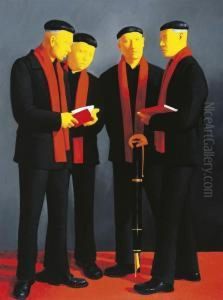Guan Tong Paintings
Guan Tong was a Chinese landscape painter from the early Five Dynasties period. He was born in the early 10th century and lived during a time of great political upheaval, which saw the transition from the Tang Dynasty to the Song Dynasty. Guan Tong is often associated with the development of the monumental landscape painting style that became prominent during the Five Dynasties and Song periods.
Although much of Guan Tong's life is shrouded in mystery, he is known to have been a native of Chang'an, the ancient capital of China during the Tang Dynasty, which is present-day Xi'an. Guan Tong's painting style was heavily influenced by his predecessor Jing Hao, who was also a prominent figure in the development of Chinese landscape art. Guan Tong is often mentioned alongside his contemporary, Li Cheng, and together, they are considered to have set the stage for the great landscape painters of the Northern Song Dynasty, such as Fan Kuan and Guo Xi.
Guan Tong's landscapes are characterized by their use of 'wrinkled' texture strokes (cunfa) to depict mountainous terrains, which give his paintings a rugged and vigorous quality. His works often convey a sense of vastness and the natural grandeur of the landscape, reflecting Taoist and Buddhist concepts of nature and the universe. Unfortunately, no verified original works by Guan Tong have survived to the present day. However, later artists and scholars have attributed certain paintings to him based on stylistic analysis and historical records.
Despite the scarcity of surviving originals, Guan Tong's influence on Chinese landscape painting has been profound. His approach to landscape art laid the groundwork for later developments in the genre and continued to inspire Chinese artists for centuries. Guan Tong's life and work are integral to understanding the evolution of landscape painting in China and the aesthetic principles that underpin this tradition.



